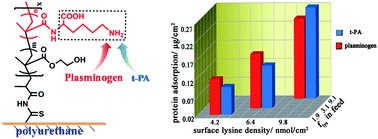A new strategy to regulate the attachment of plasminogen and its activator, t-PA, to a polyurethane surface is reported. The method is based on the one-step graft copolymerization of a lysine-containing methacrylic monomer and hydroxyethyl methacrylate (HEMA). The copolymer-modified PU surfaces showed high capacity for plasminogen and t-PA binding. The release of pre-adsorbed t-PA from the lysine-containing PU surfaces in contact with plasma was also investigated. It was shown that the interactions of plasminogen and t-PA on this type of surface can be controlled simply by changing the monomer feed ratio, and thus the relative quantities of HEMA and lysine in the grafts. This approach may be useful for the development of fibrinolytic, blood-contacting materials and, more generally, for controlling protein-surface interactions for biocompatibility.
